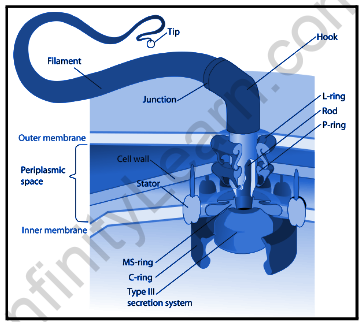Table of Contents
Introduction
Flagella refers to the hair-like structures found in the cell body and plays an important role in regulating and maintaining its various bodily functions. The word ‘flagellum’ has a Latin origin meaning whip. This indicates a long, thin whip-like structure.

The flagellum is a characteristic of members of the Mastigophora, a type of protozoan group. However, these structures have also been found in bacteria, fungi, algae and animals. Flagellum plays a role in the organelle of locomotion in biodiversity. These structures also help these insects to collect food and move around. Let’s read more details about the basic structure, functions, and types of the flagellum.
Flagella: Structure
The size, shape, and number of flagellum vary between eukaryotes and prokaryotes. In prokaryotes, differences exist between the archaeal genus and the bacterial species. Similarly, there are many variations in the structure and use of flagella. However, some flagellum structures are more common in all walks of life. The basic structure consists of three main parts: the filament, the hook or attachment structures, and the basal body or device.
- Filament: The most prominent part of the flagellum fiber. In fact, about 98% of all flagellum structures are represented by the filament. The filament extension extends from the chicken-shaped structure found within the cell cytoplasm. Variation occurs with filament length in groups of living organisms. These structures integrate naturally. They are made of hook proteins and flagellins. In addition, there may be differences in the number of flagellin subunits and hook protein subunits in different cells.
- Hook or anchoring structures: The flagellar hook is a short and curved tubular structure. It acts as a link between the basal body and the long strand. The main function of the hook is to transfer motor torque to the helical filament. This facilitates the movement of the helical filament in a different way for different functions. The hook is also important in flagellum fusion.
- Basal body or motor device: The basal body is the only structure of the flagellum within the cell membrane. Its connection has a hook, which connects to a long string. The structure of the basal body is shaped like a rod. There is a system of microtubule rings (alpha- and beta-tubulin subunits) within it. Part of the basal body varies from cell to cell.
Flagella: Functions
Below are the different functions of the flagella:
- They serve as the main building blocks of a wide variety of bacteria. Thus, they allow the movement of bacteria in a highly beneficial environment.
- The flagellum is essential for binding tissue sites to attack the underlying tissue.
- In some bacteria, there is a flagellum involvement in the exchange of nutrients and waste. This occurs by spreading the waste shell found inside the bacteria.
- They play an important role in motility and eventually fertilize eukaryotic cells like sperm.
- The flagellum is important for colonizing an environment such as soil, plants, or animals in a healthy way.
- In alkaliphilic bacteria, flagellum works in a sodium-driven manner. It facilitates the re-entry of sodium into the cytoplasm to maintain a neutral cytoplasmic pH.
Types:
There are three types of flagellum: bacterial, archaeal, and eukaryotic.
Bacteria
- They are slightly curved structures than the other two species — archaeal and eukaryotic.
- The bacterial flagella is made up of a type of protein with a low molecular weight.
- They are small compared to the eukaryotic flagella.
- Its diameter is estimated to be 20 nanometers.
Note- Depending on the number of flagella bacteria in the following species- Atrichous- No flagella present
- Monotrichous– One flagellum present.
- Amphitrichous– Two flagella are antibacterial.
- Lophotrichous– Many flagella are present at any time in the bacterium.
- Peritrichous– Flagella is still spread on the surface of the virus.
- Cephalotrichous– Two groups of flagella in two opposing areas store bacteria.
Archaeal
- This type is a unique motility tool. This is because it is different in structure; it is the same when it comes to combining bacterial species.
- The emergence of archaeal species in almost all major clusters of various domains. Such domains are thermophiles, methanogen, and halophile.
- There is a difference between the archaeal type and the bacterial species in general. This is because the archaeal fibers are thin.
- The protein sequence in the archaeal flagellum in the right helix of the right-hand leads to a clock rotation of the archaeal type.
Eukaryotic
- The eukaryotic flagellum is present in a variety of algae and other animal cells such as sperm.
- There is a link between eukaryotic flagellum and reproduction, cell nutrition, and cell movement in eukaryotic animals. It also acts as a nerve horn in some types of algae.
- There is a difference between the eukaryotic type and the bacterial type in the composition, mechanical, structural, and structural design. The eukaryotic variety is made up of many types of proteins. In contrast, there are only 30 protein types in the bacterium.
FAQs
What Is the Role of Flagella in a Bacterial Cell?
Flagellum helps organisms move and experience changes in temperature and pH. It is also helpful to identify certain organisms quickly. Also, it speeds up the reproduction rate of eukaryotes.
Where can Flagella be found?
Flagella is found on the back of a unicellular organism or cell body. The flagellum has a tail-like appearance and is primarily responsible for the movement of organisms.
What Are the Types of Flagellation?
There are 6 types of bacterial flagellation - i. Atrichous ii. Monotrichous iii. Amphitrichous iv. Cephalotrichous v. Lophotrichous vi. Peritrichous. Remarkably, each of them has a unique structure that sets them apart.







